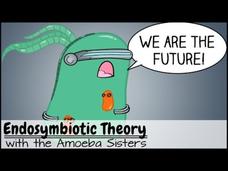Curated Video
Plastids and Mitochondria
Plastids and Mitochondria examines energy transformations by describing the fundamental roles of plastids and mitochondria.
Schooling Online
Biology Cells as the Basis of Life: Cell Structure - Plant Cells Part 2
Sally’s field trip to the Garden of Babylon is turning into a road trip. Her first stop is the post office. It’s not every day that a stork delivers your mail! This lesson will continue unearthing the structure of plant cells, focusing...
Schooling Online
Biology Cells as the Basis of Life: Cell Structure - Animal Cells Part 3
Seeking excitement, Sally embarks on a self-guided ghost tour of Zoo York’s ‘abandoned tunnels’. Will she spot anything spooky? This lesson will finalise our crash course on the structure of animal cells, focusing on components...
Journey to the Microcosmos
The Microbe That's Big Enough to Pet
The Microbe That's Big Enough to Pet
Bozeman Science
Compartmentalization
Kleenex folded in a box is similar to mitochondria in a cell. Llearners explore how eukaryotic cells have specialized organelles that increase the surface area of the cell without making it smaller. E.coli, Halobacteria, and...
Bozeman Science
Cellular Organelles
Despite their microscopic size, eukaryotic cells are probably one of the most complex systems ever! Explore the structure and function of the major organelles of eukaryotic cells — the nucleus, ER, ribosomes, golgi complex, lysosomes,...
Curated OER
A Tour of the Cell
The differences between prokaryotic and eukaryotic cells are explained and the parts of each are highlighted. Discover the major organelles found in an animal cell and each of their functions. Paul Andersen does an excellent job once...
Curated OER
Photosynthesis: Light Reactions
This clip picks up right where the Khan Academy's Photosynthesis video left off. Chemicals such as hydrogen and compounds such as NADPH are reviewed along with details including the stroma, thylakoid, lumen, and grana. See the parts of a...
Curated OER
Advanced Genetics
Are your biologists ready for advanced genetics? Briefly learn about Gregor Mendel, and dive into the phylogenetic tree, linked genes, multiple genes and nonnuclear inheritance! Mr. Anderson continues his clear instruction and use of...
Curated OER
The Inner Life of a Cell - Harvard University
The inner life of a cell is laid out like a science fiction film. With dramatic music playing in the background, show your learners how the organelles interact and perform. This highly scientific clip is very detailed and is geared...
Bite Sci-zed
Mitochondrial DNA
Do young scientists know that some traits are only passed down by the mother? Mitochondrial DNA is an interesting phenomenon that provides researchers with a lot of useful information. Scholars learn about the endosymbiotic theory, what...
PBS
The Two People We're All Related To
Is it possible all current lineage trace back to one male and female? Mitochondria DNA suggest just that! A lesson with this interesting perspective on genetic heredity explains how all human DNA connects to a single male and female in...
Amoeba Sisters
Endosymbiotic Theory
Eukaryotes—were we born from an act of predation that backfired? Ponder this and other questions of evolution with a video from a well-written biology playlist. Topics include the origins of mitochondria and chloroplasts, unusual...
Amoeba Sisters
Specialized Cells: Significance and Examples
All cells are created equal, but some go on to do amazing things! Find out more about these super hero cells with a short video from a well-written biology playlist. Topics include specialized plant and animal cells and how cells know to...
Amoeba Sisters
Introduction to Cells: The Grand Cell Tour
Ready to begin cell biology in a grand fashion? Start the adventure using a short but thorough video from a vast biology playlist! From prokaryote to eukaryotes, Golgi to chloroplast, the narrator guides viewers through the cell membrane...
PBS
How Two Microbes Changed History
Where would we be without bacteria? As it turns out, we owe them everything! Introduce young biologists to endosymbiotic theory using an amazing video from an extensive biology playlist. Scholars discover the bacteria that may be...
American Chemical Society
The Cold Truth About Fat
Our bodies store two types of fat: brown fat and white fat—and brown fats are actually efficient at burning calories! An episode of the ACS Reaction series compares exercise generating brown fat to shivering cold. It turns out 15 minutes...
Teacher's Pet
Photosynthesis and Respiration
A video describes the relationship between anaerobic respiration and photosynthesis and then connects the cycle to the creation of ATP.
Be Smart
The Most Important Moment in the History of Life
Scholars learn about the first endosymbiosis, which lead to the production of the first organelle, mitochondria that are able to change shape, divide, reproduce, or grow larger, providing what is needed by a cell. The rest of the...
Be Smart
Every Breath You Take Is Connected
Take a deep breath before you watch this video. Viewers learn about how every breath is connected due to the cycling of carbon dioxide and oxygen. A split-screen video allows viewers to consider both cycles at once.
















